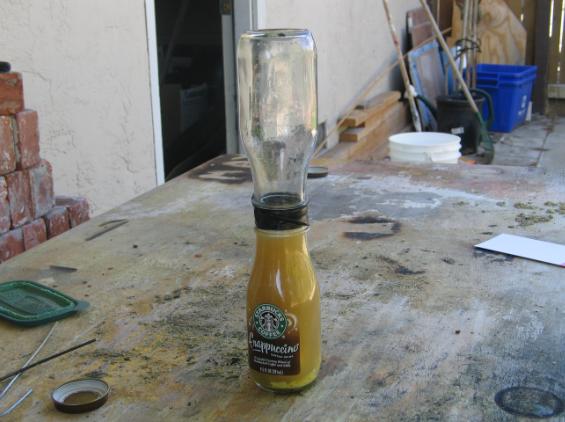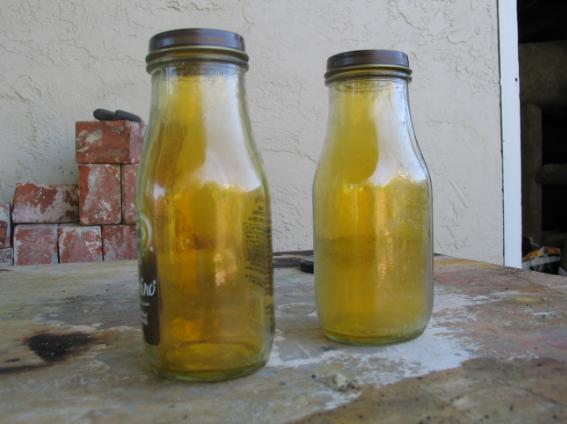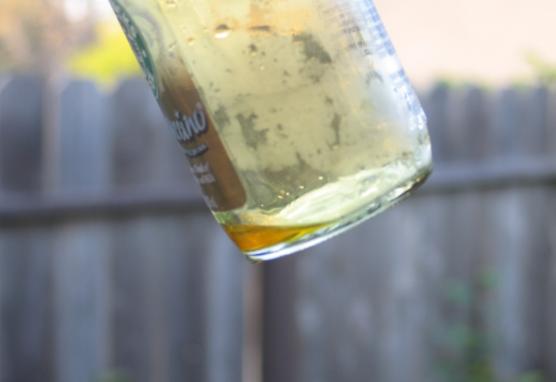

max.yevs
Senior Members-
Posts
130 -
Joined
-
Last visited
Content Type
Profiles
Forums
Events
Everything posted by max.yevs
-
sorry YT and hermanntrude, guess i must have undestimated the toxicity of NO2, wasn't trying to seem outrageous... but yeah pulmonary edema is quite scary... and i don't take it personally; if i could i would edit that post... but i don't plan on using any niric acid anytime soon anyways.
-
lids are made of metal, probably aluminum . but i used up the BrCl very quickly, as soon as i cooled it down to a liquid. Only a tiny bit of corrosion present on their surface, which doesn't surprise me... have you ever tried reacting aluminum with chlorine? almost impossible... and chlorine is more reactive then BrCl And don't worry, i'll stop posting projects on sfn, i've started a free website, i'll just post them there and maybe refer to them when needed, like woelen does. and save this forum for actual questions . i like the way that sounds, lol. oh, im pretty sure its Bromine monochloride (with some chlorine). Unless you're referring to my iodine monochloride idea, then im not sure if its a solid or liquid because there are two 'polyphorms', one of which melts at 13 degrees C, and the other at 27.
-
oh right, im an idiot... the atom stays at a mass of 11... which throws off that whole post.
-
yeah, i'll be careful don't worry plus when making some gas, i usually wear a respirator + goggles, and do it outside (of course!) what's not very good about NO2 that it can give you pulmonary edema a lot later, without any ill effects right away... at least the halogens you can smell very easily; NO2 supposedly anesthesizes the nose in small quantities so you can't smell it. not sure why i got an infraction, but i do realize i got to start posting projects onto a my own website...after all this is a forum...
-
Vaccuum by itself would not work, it also requires a strong magnetic field to keep them in place. Only way i've found that positrons are made is some types of positron emission: 11/6C → 11/5B + positron + neutrino + 0.96 MeV Summary of All Nuclear Physics Part 1: Antimatter I think I've got it figured out: neutron = quarks + neutrino + electron + positron proton = quarks + positron + neutrino antiproton (antimatter proton)= quarks + electron + neutrino quarks = mass, non-charged electron = charged positive, miniscule weight positron (antimatter electron)= charged negative, miniscule weight neutrino = non-charged, miniscule weight And what is light, gamma rays, and other parts of the electromagnetic spectrum? Pure energy. For example, antimatter annihilates matter (i.e. electron + positron, antiproton + proton) to create pure energy. These rays often excite atoms to release heat. So basically, antimatter is like a picture with its colors reversed. The nuclei have antiprotons instead of protons, and so are negative. The negative electrons flying around are instead positive positrons flying around. Now lets consider positron emission again 11/6C → 11/5B + positron + neutrino + 0.96 MeV the proton basically just breaks up proton → quarks + positron + neutrino This also lets loose the electron which had been orbiting that proton. Without a strong magnetic field, they annihilate each other. Question is, where do the quarks go? According to Einstein’s special relativity, [math]E = mc^2[/math], mass is actually converted into energy, which is where the 0.96 MeV come from. That puts a nice bowtie on all the nuclear research ever done...
-
thanks, that's quite a collection of gas data sheets! yeah i guess its toxic, although i won't believe for myself until i actually get near it... in any case, i've got distracted by some other more interesting projects, although i'll probably try this when i happen to have persulfates on hand and/or need some sulfuric or nitric acid...
-
right, but an electron + proton = neutron electron + positron = energy its like your avatar picture thingy- pretend all those green numbers are antimatter
-
actually, BrCl could be more useful then chlorine, i guess... after pouring those couple drops on a piece of aluminum foil, it started fizzing quite a bit... and i don't think evaporating is really much more of a problem then with bromine... i think if i had a decent quantity i might have seen some flashes, after all, it is more reactive then bromine... i will probably pursue a decent quantity of Br2 or BrCl sometime... Iodine monochloride is another interesting interhalogen, thats liquid or solid at room temp, i suppose it could be made similarly by [ce]NaI + HCl -> NaCl + HI[/ce] [ce]HI + HOCl -> H2O + ICl[/ce] Actually I might try that one pretty soon.
-
here's a better picture... to my surprise, the whole pipe section thingy dissolved after about 24 hours... Its a nice clean dark green color, although i put it out in the sun to evaporate, around the edges its forming nice bluish/light bluish/cyanish crystals... i assume its copper chloride. //Thread Closed
-
SUCCESS! I've successfully made bromine monochloride from those 1-Bromo-3-chloro-5,5-dimethylhydantoin tablets... first of, those tablets are 100g, 33g bromine and 37g chlorine... they release HOBr and HOCl... 100g tablet in a small 280ml bottle, about 200ml HCl added... Although the tablets turned slightly brown originally, it quickly turned yellow and kept releasing chlorine for about 2 hours... as you predicted hermanntrude. then i realized... i have only added about 40g HCl, and maybe the reaction [ce] HCl + HOCl -> H2O + Cl2 [/ce] is favorable over [ce] HCl + HOBr -> H2O + BrCl [/ce] this would leave practically no HCl to react with the HOBr. Losing all hope, i decide to put pieces of aluminum in there. Aluminum reacts very nicely with it, more quickly and powerfully then with the same 20%HCl i used for it. After putting in big chunks of aluminum, i noticed that a brownish gas began to form, pretty rapidly...i collected some in two bottles (picture 2). I assume i made bromine chloride- when chlorine was being made before, it was almost colorless greenish yellow with no red tinge. Despite being great that its an interhalogen. Oh and its quite irritating if you breath it. Its like chlorine, but instead of giving you one pungent whiff, it keeps irritating your nose/throat. But it's not too bad... Oh and I did it very unefficiently. Simply to prove the concept. Those tablets could have yielded 50 grams BrCl, about 15 liters (gas). After spending a little time in ice, you can see a bit of liquid bromine chloride (picture 3). I realize for all the chemists here, this is a very simple experiment... maybe they can explain why the aluminum did what it did...
-
i've currently got it running, i'll say what results i got later but can anyone tell me, which of these reactions is favorable? [ce]HCl + HOCl -> H2O + Cl2[/ce] or [ce]HCl + HOBr -> H2O + BrCl[/ce] ?
-
how toxic exactly is NO2? they say chlorine is toxic, but i've dealt with it several times, never feel any ill effects (the smell is not even that bad, until you get a good whiff of it, that makes you jump back)
-

Two water-filled buckets. One swinging. Which empties first?
max.yevs replied to Neil9327's topic in Classical Physics
nice, im glad someone decided to actually do it... what i said before is not completely correct, if you're on some planet with very high gravity, centrifugal force might be irrelevant... -
yeah halogens are pretty hazardous, althought there are at least several different ways to make chlorine (i.e. HCl + bleach/HOCl/MnO2 or by electrolysis), but yeah i can't do anything interesting with it because im at a loss for apparatus. iodine is pretty awesome, i made it once from NaI (NaI + HCl > NaCl + HI; 2HI + H2O2 > 2H2O + I2)... reacts with aluminum very similarly to bromine- and with a nice purple smoke of gaseous I2... but it wasn't very efficient since I had to make out of tincture instead of NaI crystals... i can't find how woelen makes bromine, i assume its either out of NaBr or KBr- maybe bubbling chlorine through it? unfortunately i'm at a loss here in both apparatus and bromide salts. ** sorry UC, no turning back now. I've already set it up to react with HCl tomorrow... I'll post a picture if it works. (although I wouldn't be making bromine, i'll probably be making bromine monochloride)... i don't know if electrolysis is better, but it's such a drag i'll rather just do it with acid.
-
you know a way to strip off all the electrons from a compound, right? heat it into a plasma .... with enough energy, electrons dont want to stay tied so close to their nuclei, they'd much rather fly around randomly!
-
i happen to have a good amount of these disinfecatry tablets which are 33% bromine by weight, as they release HOBr and HOCl in water... anyways, is there any way to extract bromine from HOBr? i have two ideas in mind- one is two electrolyse it- [ce]HOBr -> H^+ + OBr^-[/ce] [ce]2H^+ + 2e^- -> H^2[/ce] [ce]2OBr^- -2e^- -> O^2 + Br^2[/ce] one is too react it with hydrochloric acid- [ce]HOBr + HCl -> H2O + BrCl[/ce] except i don't know what to do with BrCl, although its boiling point is pretty high, 5 degrees celsius, so i could make it liquid basically what i want to achieve is something like this
-
thanks hermanntrude, i have Na2S2O8... from what i've done with it so far, i think it donates a sulafte ion- a radical thought, i dont know if its true... and sulfates are in themselves weak oxidizers since they release oxygen at high temp. yeah yt, this the thing i dont get with copper- its less reactive on the activity series then hydrogen, and it does not react with most acids, which is why i think it would work, though im not sure... it would be nice to get sulfuric acid, though- its used in a lot of experiments Merged post follows: Consecutive posts mergedwell i'll post a picture if it works... when i do try it... it's really the only way i can think of to get sulfuric acid... if i do get H2SO4, ill react it with NH4NO3 to try to get nitric acid... and then if i can get some copper to dissolve in it, that will be proof that it worked copper + nitric acid or i suppose i can put sugar in it
-

Two water-filled buckets. One swinging. Which empties first?
max.yevs replied to Neil9327's topic in Classical Physics
despite of where gravity is at what point, the centrifugal force always pushes the contents outwards, thus the one swinging will empty first. -
i suppose he meant it like between atoms, and their nuclei, since nuclei of atoms are positive they repel each other until they are close enough that gravitaional forces take effect; then the nuclei might fuse, as in nuclear fusion
-

...I'm lost with these ALUMINUM wires, need some help here
max.yevs replied to bearnybear's topic in Homework Help
are you sure they were aluminum wires? not steel? and not the type used for soldering, which are tin/lead? well regardless of what metal you used, i doubt you got chloride, if anything you probably got oxide- i.e. aluminum oxide because salt helps facilitate rusting. -
nah, cap'n is right, i orignally mispoken. [math] \sqrt{4} = \pm 2 [/math] but look at post #8, i think it captures the idea behind this whole thread.
-
yeah, its outdoors... and i just remembered i forgot they had to be put in right proportions and thanks, i got the idea of substituting with NH4NO3 from you on another post ah sorry didn't see the latex equations at first, so from what i see, this is the basic idea... a small amount of ammonium nitrate turns into nitric acid, which oxidizes copper (your first/third equation) the NO2 released partially helps reformulate the nitrous and nitric acid (your fourth/fifth equation) nitric and nitrous acid react with HCl to give N2, Cl2 and NOCl (and NOCl > 2NO + Cl2) (your sixth/seventh/eighth equation) the chlorine also oxidizes copper... (your ninth/tenth equation) here's a picture... you can definately see and smell a little chlorine sometimes i can see little brown traces of what looks like NO2, but i can't say for sure actually copper was not the best metal to choose for this experiment, since nitric acid by itself can eat through copper. even vinegar + H2O2 can dissolve copper
-
given the amount of speed of light questions here, this may have been answered already, in that case i apologize in advance. light moves at a speed of 670,616,629 mph... now, say you are driving a car at 50 mph, and you turn your headlights on- will light be moving at 670,616,679 mph? or would it still be moving at 670,616,629? or is it like soundwaves that it will become compressed and turn into a higher frequency? so if you're going faster than the speed of light, would you be shining behind you? and if you're going exactly the speed of light, would your headlights blow up from illuminating all their light onto themselves? i'm sorry, almost the same exact post is 15 posts below... if admin knows how to remove this thread, please do
-
I already have this experiment running- 20.2% HCl + excess ammonium nitrate = poor man's aqua regia It is slowly eating a piece of copper pipe (and we all know HCl could not do this by itself)... the solution is becoming a very dark greenish, anybody know what this copper compound is? a little bit of chlorine is being produced- you can see its distinctive color on the surface is it really just copper chloride? then how does ammonium nitrate come into play?
-
ok, yeah, not in any forseeable future... i was just thinking why they don't create antimatter bombs, kind of like nuclear bombs- because it will take a tremendous amount of energy to actualy create the bomb. only upside is storage- all that energy could be stored in one bomb- or one battery for that case.




